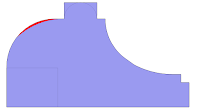These pursuits are actually how I was originally attracted to hollows and rounds. With hollows and rounds I am limited by my skill but not by what bits I have in my drawers or Freud has in their catalogues. (i.e. I've started a new project and the very last thing I'll consider are the intricately specific profiles. I know I can make them, it's just not a concern.)
I put up a post on my blog yesterday regarding a custom moulding plane I was commissioned to make. This profile is a "Grecian" profile vs. a "Roman."
Roman ogee on the Left, Grecian on the Right
Sometimes I wish I wanted to learn about the reigning empires, major players, and world affecting events of the period that may have led to the evolution that greatly affected my Wednesday of this past week. In fact, maybe the proper thing to do is go read about the subject for a few hours, make broad statements that I cannot cite, and then hope a few specific people won't read my blog. This will then certainly dazzle you with my Wikipedian-like "knowledge," right? Well, I won't.
I'll just quickly make a broad generalization about the the difference between Roman and Grecian profiles that may define a few terms I reference on occasion: Roman profiles are made out of circle segments and Grecian profiles are made out of elliptical segments.
Again, Roman on the Left, Grecian on the Right
Hollows and rounds allow me to copy both. I know I can make the plane I was commissioned to make. Additionally, I can make the profiles I may want to make in the future: circular vs. elliptical, Grecian vs. Roman, and William & Mary vs. Chippendale vs. Becksvoortian (AKA Shaker, AKA no moulding planes).
Note 1: I know and care more than may let on here.
Note 2: Please send a single email to matt@msbickford.com with the subject of "Raffle" to enter to win an 'X-out' 7/8" rabbet plane. I did a contest like this last year. I go out of my way to keep the winner to being a reader. If the contest gets posted on Instagram, Twitter, Tinder, etc. then I'm going to cancel or postpone it. I don't want the publicity, likes or follows. (You don't even have to sign up for my mailing list, nor will you be put on it.) Don't decrease your chances of winning! Like last year, the contest winner will be chosen randomly in an ultra-transparent manner. This won't be me giving the plane to the person with the highest Iprofile. Like last year, I will ship this plane anywhere that USPS will deliver, their rules/relationships not mine. US and Canada? Sure. Germany and Australia? Definitely. The Congo? Probably not, I don't know. But you're probably fine to enter. The specific rules will be defined once the entry period is over. I am the final arbiter. Entries must be made before 23:59 EST on 1/4/19. The plane will work perfectly, I just don't like the piece of wood. If you win and you've already purchased a rabbet plane directly from me then I'll find something else for you.
























































